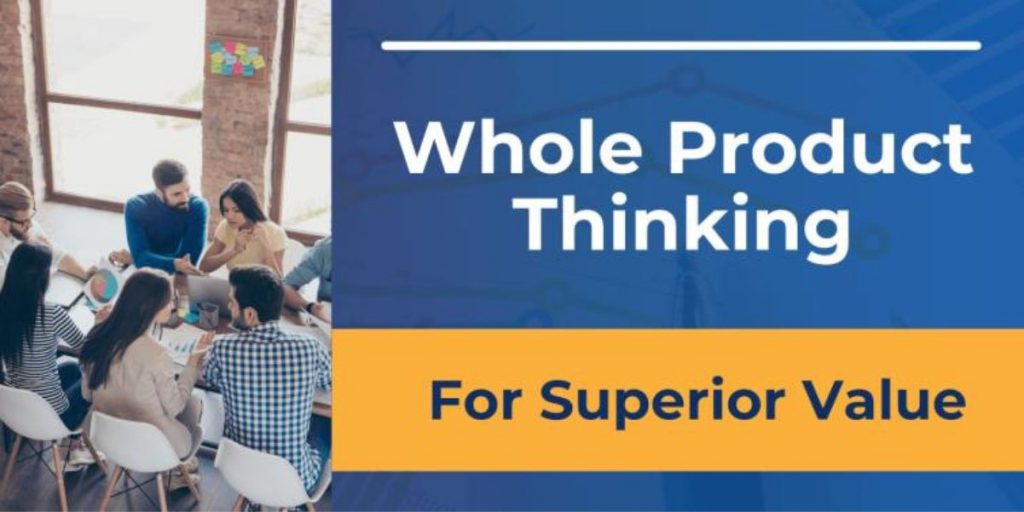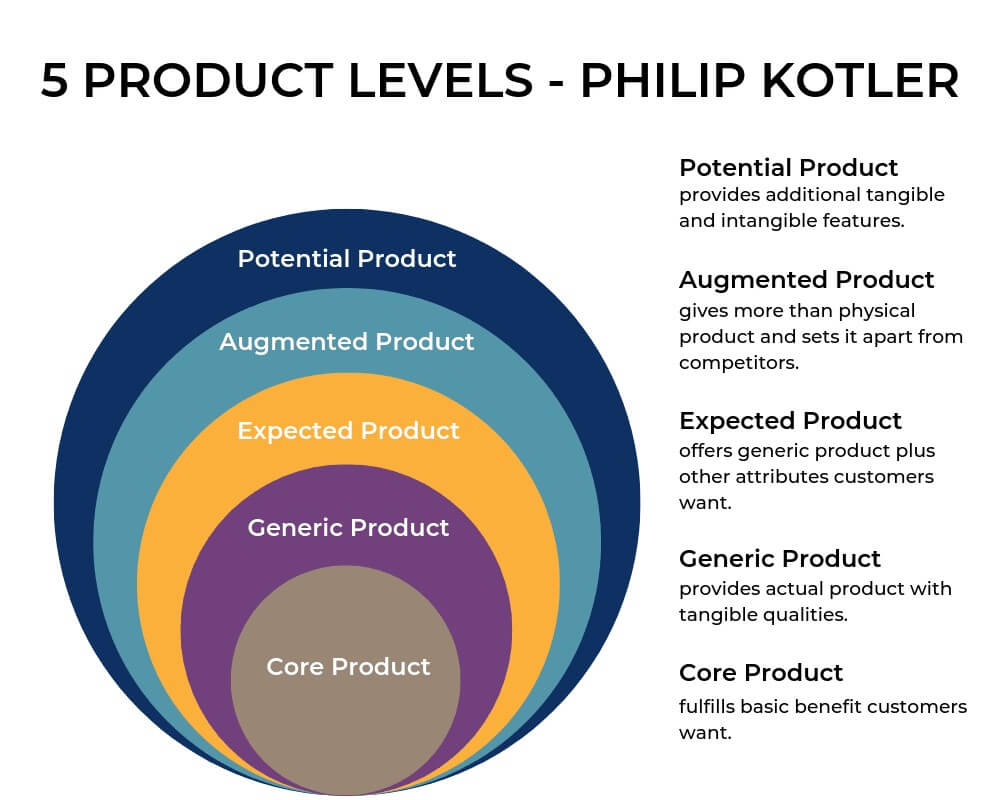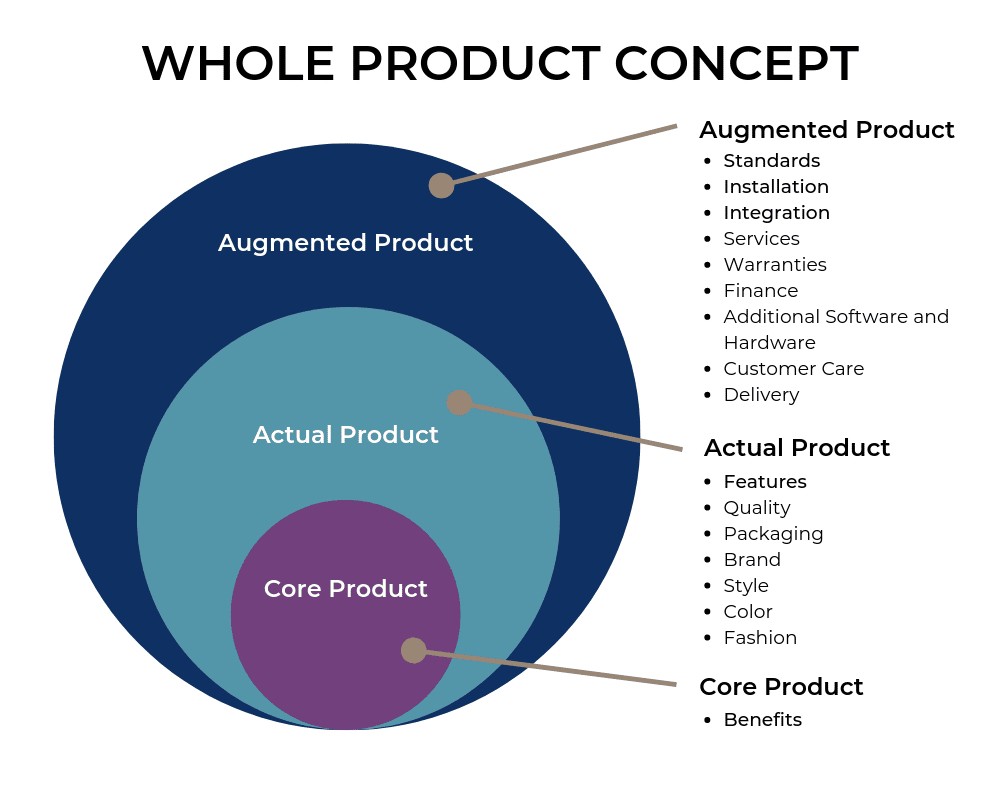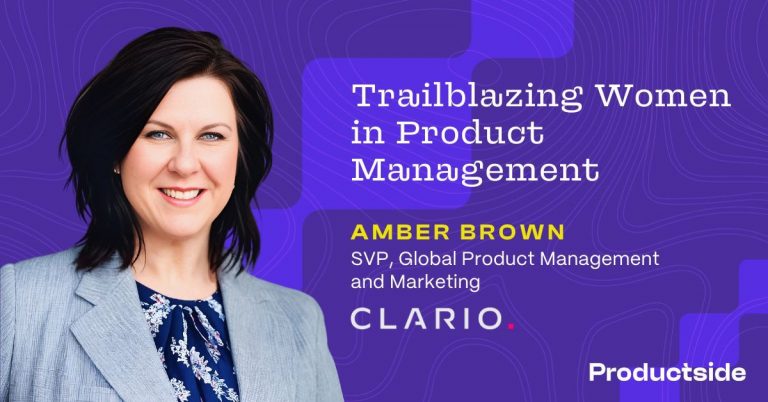
What is Whole Product Concept?
Whole Product Concept involves viewing your product as more than just a sum of its features, but rather as everything involved with the experience customers have with your product. To develop your Whole Product Concept, start at the core – what are the real benefits that your customers expect to receive or experience from the product? Then expand your thinking to consider all aspects of the customer’s experience, from purchase, first use, experienced usage, maintenance, add-ons and accessories, even to how the product may be replaced or upgraded. Consider all of the touchpoints your customer will have with your product.
What is Whole Product Concept?
Whole Product Concept involves viewing your product as more than just a sum of its features, but rather as everything involved with the experience customers have with your product. To develop your Whole Product Concept, start at the core – what are the real benefits that your customers expect to receive or experience from the product? Then expand your thinking to consider all aspects of the customer’s experience, from purchase, first use, experienced usage, maintenance, add-ons and accessories, even to how the product may be replaced or upgraded. Consider all of the touchpoints your customer will have with your product.

Whole Product = Whole Experience
To help our understanding, let’s use a car as an example. If you buy a car that has the features that you want but it doesn’t have some of the other critical components of your ownership experience, like a nearby service center, an adequate warranty, availability of parts, etc. then you won’t be happy. The whole product is the entire experience, not just the features of the product.
Another related mistake that Product Managers often make is, again, focusing on features. Customers don’t care about features (I know that doesn’t sound true, but stick with me). What customers care about is the benefit that the feature provides for them. Using cars as an example, one of the features of the Prius is that it gets >50 MPG. What’s the benefit? It is much less expensive to drive and saves you time because you don’t have to buy gas as often as other vehicles. So, while some customers do buy a Prius for the hybrid feature itself, most purchase it for the fuel and time-saving benefits.
Variations on the Whole Product Concept
Below is another variation of the Whole Product Concept that we teach in our Optimal Product Management course where we emphasize benefits as being at the core of the Whole Product.

As with many aspects of Product Management, you might not have direct control over all aspects of your Whole Product offering. But as a Product Manager, you should do everything possible to influence every area so that your customers are delighted. As we say in the Product Management Manifesto, “Though I have all of the responsibility, it is highly likely I have little or no formal authority. Therefore, I will do whatever it takes to persuade others to do what is right for our customers and my company
Using Whole Product Thinking to Turn Challenges Into Opportunities
While much has been written about how companies and Product Managers have had to pivot during the pandemic to stay in business, Whole Product Thinking can help identify how to pivot or make changes to the Augmented product to create new opportunities. Let’s discuss a couple of examples we’ve seen happen.
Virtual wine tasting
Many wineries realized that when customers could no longer visit them and taste their wines, they needed to find new ways to engage with their customers. This wasn’t a change in the core product (enjoyment and health benefits of wine) or actual product (the wine itself), but changes in augmented product characteristics: service and delivery. How can you look at changing customer needs due to the pandemic and offer a different approach to your service and delivery?
Movie theatre popcorn – at home!
Sometimes, as a Product Manager, you should think about augmenting an already supplemental product to your normal product experience. In this case, my local movie theatre, which can’t sell its primary experience – watching a movie in a movie theatre – is instead offering its secondary products for sale. On Friday and Saturday afternoons, from 4:00 – 7:00 PM, I can swing by the theatre and buy a pocket of fresh-popped popcorn, an Icee, and even Dibs ice cream. Sure, I could buy substitutes at the grocery store, but my theatre recognizes that they do have differentiated value (and high-profit margins) in their products, so they have been very successfully offering them at times that work for their customers. If you can’t offer your primary product right now, can you sell some of your secondary products in a different way?

If you haven’t already, I encourage you to use the Whole Product Concept and write down everything about your product. Start at the Core – what are the real benefits that my customers expect to receive or experience from my product? With that in mind, then consider the features needed to deliver these benefits. Then expand your thinking to consider all aspects of the customer’s experience, from purchase, first use, experienced usage, maintenance, add-ons and accessories, even to how the product may be replaced or upgraded. Consider all of the touchpoints your customer will have with your company – Sales, support or sales engineering, customer service, online resources, forums, etc. How can you best enable each of these touchpoints to provide the right service at the right time to your customer? Think about all of the augmented attributes in our model above that you want to ensure provide the right customer experience. It may change the way you view your product management role, and it might just help your product and career succeed.


